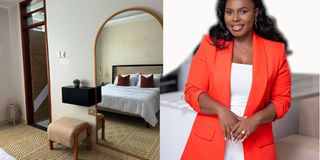
With a few accessories, Geogina Mwebaza is able to turn every space around. She is the proprietor Spicing Homes.
Picture this: You have been looking for a place to call home for weeks. After being dragged to every dilapidated vacant house, you end up finding one which looks less than a condemned house. Even if it is not the fancy home you had in mind, you choose to move in in spite of the cracked walls and fixtures that could be older than you. Where most logical arguments would go against spending money to turn that dilapidated house into a home you love, you know you should do so since you are going to be living here for the next few years. But, where do you start? For instance, what kind of repairs and upgrades will the landlord sanction, what is affordable and what is simply out of you reach? This is where Georgina Mwebaza, an interior designer comes in. Mwebaza, the founder of interior design firm, Spicing Homes, specialises in helping tenants customise their rentals to their liking.
For the last seven years, Mwebaza has been engaged in a campaign to change people’s mindsets towards making their rented homes look and feel better. Mwebaza says to make her concept relevant, she started out focusing on bathrooms.
“Because many rental bathrooms tend to be drab and small spaces, I would contact the landlords and offer to transform them. Although landlords do not like their structures altered, for this they would be willing to give it a try, especially when I explained that what I wanted to do would improve functionality,” she explains.
Just as her business was gaining momentum, the pandemic hit. And although she was at first shaken by what this might do to her budding business, this later turned out to be a blessing in disguise for her.
“When the lockdowns came, people were forced to spend so much time in their homes. This is when many of them realised how depressing their spaces were. They also learnt that these were their homes and the landlords should not have so much control over what they did with them,” she says.
This was a turning point for her business as more people started reaching out to hire her to transform their homes into cheerful and functional spaces.
Why bathrooms?
Although bathrooms are some of the most used spaces in a home, they are also some of the neglected. However, millennials have a different relationship with their bathrooms.
“To this insta-generation, the bathroom is more than a place of convenience, it a place to relax, unwind with a book or a glass of wine after a long day at work. These are not activities that can be supported by a cramped, damp and unpleasant space. This is why many of the people who reach out often want bathroom revamps,” says Mwebaza.
The interior designer notes that while most bathrooms in rentals are small, there is so much that can be done to make them more appealing.
“I once worked on a bathroom so small that it was difficult to get in and out. The landlord simply crammed the toilet, shower and sink leaving no possible space for anything else. To try and create an illusion of space, I added a mirror and changed the lighting and to reduce clutter, I added shelves on the walls and the place looked much better,” she says.
Mwebaza also often adds decorative elements such as a plant or wall art to liven up the space. But most importantly, thorough cleaning up the bathroom also makes a great difference.
“The bathroom receives heavy traffic, which is why it is important for it to remain clean. Apart from hygiene concerns, a dirty bathroom looks outdated and unpleasant,” she notes.

Apart from hygiene concerns, a dirty bathroom looks outdated.
Starting out
Mwebaza traces her interest in interior design back to her childhood. Her father, who was an outdoor advertising executive, would bring pieces of leftover materials used for billboards.
“I would spend hours and hours building and decorating spaces with those pieces. Eventually, I progressed to experimenting within our home, I would clean, move furniture and change things around, which irritated my father so much because he likes having his things a particular way,” she recounts.
One time the budding designer asked her father why he kept changing her arrangements.
“He told me that he had arranged the furniture in a way that enables him enjoy his space. ‘Do you see this chair, it is in this spot because if when I sit in it, I am able to enjoy that art piece on the wall while also enjoying a fresh breeze from outside,’ he said to me. This is when I started learning how to get the most out of a space,” she says.
Although at university Mwebaza chose to pursue a degree in entrepreneurship, she continued doing interior design as a hobby.
“After I had my baby, I found myself getting depressed by the way my home looked. I decided I would transform it into a place I would be happy to spend so much time. I embarked on different DIY projects that would make the space easier for me now that we had a baby. I ended up with a space that many of my friends and family loved so much that they asked me to do the same for them,” she recounts.
But most impressed was her landlord, who paid her for the alterations when she finally moved out of the house.
This was the affirmation she needed to realise she could turn a hobby into a business. To get formal training, Mwebaza enrolled at the Institute of Interior Design in South Africa for a diploma.
Her efforts have been rewarded by the appreciation with which her work is received.
“My biggest satisfaction is seeing my clients enjoying the spaces I create for them,” she says.
For her, interior design learning is a continuous process and she seeks out and connects other professionals in her sector to connect with and learn from.
“Through these connections, I have been able to get clients, contractors and materials that would have been difficult to get on my own. I also get mentorship from more established designers which has greatly impacted my work,” she says.
Opportunities
Mwebaza is excited by the vast business opportunities in the industry and urges others to take advantage of them. “The market is still large and untouched. Homeowners are slowly adapting to the idea of letting a professional design their houses for them, what we need to do as an industry is make ourselves available and deliver to the best of our abilities. I use social media platforms to market my services and so far they have been effective,” Mwebaza says.
Cognizant of the need for more players in the industry, Mwebaza organises short courses and masterclass sessions for anyone interested in interior design. Her efforts so far have been influential in helping six different women start up their businesses.
“The masterclass is also intended to equip people that are passionate about interior design with enough knowledge to be able to do certain things on their own,” she says.

Lessons
Mwebaza says the biggest lesson she learnt is pricing her work appropriately and regrets being blinded by her passion at the beginning.
“I was driven by passion and wanted to serve more people without considering how overwhelming the work would be,” she says.
The other important lesson is not compromising beauty over function, because while beauty is good but function offers more rewards. She tips interior designers to avoid falling for the trap of creating beautiful spaces that become a problem for their users.
“Sometimes a designer gets taken up by certain colours or furniture pieces that become impossible for the homeowner to live with or use,” she says.
Advice
The interior designer urges tenants to give their homes the attention they deserve.
“While you might not be able to change much about its structure, you can make it more livable with just the right furniture, properly displayed art and lighting. You should be able to live in a place you are proud of whether it is rented or not. Your space feels different when it is filled with things you have painstakingly selected and give you joy,” she advises.
It is a common mentality for people to be reluctant about investing in a space they are just renting after all, they are going to be there for a short while.
“The right thing to do is to buy the best household items you can for the money you have, because even when you move, you will be able to use them in your next home. Quality items are more durable and give you a longer shelf life,” she says.
Take your time to invest in your home, no matter what timeframe you are working with. The designer notes that a home does not come together as quickly as TV shows lead us to believe. She therefore, cautions against rushing to fill the space.
“It is okay to buy what you need to live your life, but you do not have to decorate every space right now. Pick the spaces you spend the most time and start there,” she advises.
Major repairs or renovations
Mwebaza notes that you do not have to own a place to make it feel like your home. Many renters have become confortable with making their houses homes. They do not mind adding their own home accessories and finishing touches with items such as light fittings and photographs to create a sense of home. There are many types of major repairs and renovations. In general, this kind of work is done to maintain the building and improve the tenants’ quality of life. It usually involves doing work on the structure of the building itself or things like kitchen cupboards or bathroom fixtures. As a tenant, your responsibility includes ensuring that everything is clean and well-maintained, without changing anything in the unit unless you have got your landlord’s permission.
On the other hand, landlords have a duty to maintain the overall structure and exterior of the property, make sure the property’s covered with the necessary insurance, as well as resolve any issues related to utilities (gas, water, electricity).
Renovations and major repairs can only be done if they are reasonable. The question of reasonableness depends on the type of work, the need for the work, and whether the tenant has to vacate their home to do it. Urgent work may be done in exceptional and emergency situations only. Work is considered urgent only when it must be done immediately to prevent a risk to the tenants’ health or safety or to protect the apartment or building.
Generally, for any major improvements or repairs a tenant must seek the landlord’s permission.
Growth
For the last seven years, Geogina Mwebaza has been engaged in a campaign to change people’s mindsets towards making their rented homes look and feel better. Mwebaza says to make her concept relevant, she started out focusing on bathrooms.
“Because many rental bathrooms tend to be drab and small spaces, I would contact the landlords and offer to transform them. Although landlords do not like their structures altered, for this they would be willing to give it a try, ” she explains.


